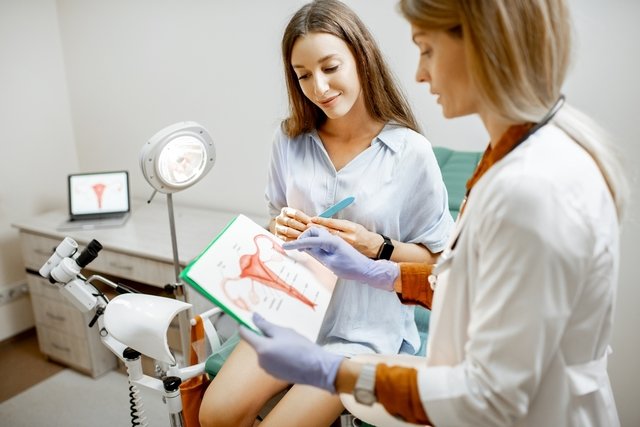Endometrial hyperplasia is characterized by an increase in thickness of the endometrium. The endometrium is the inner part of the wall of the uterus, and thickening and lead to symptoms such as increased menstrual flow, irregular menstrual cycles and vaginal bleeding outside of a menstrual period or after menopause.
Normally, thickening of the endometrium is caused by an imbalance in the levels of estrogen and progesterone in the body. This is most more common in women over 35 years of age, and women who are obese or menopausal.
If endometrial hyperplasia is suspected, it is important to consult a gynecologist so that a diagnosis can be confirmed and treatment can be started. Treatment may involve medications with progesterone, placement of an IUD with levonorgestrel and, in cases where there are pre-cancerous lesions present, surgical removal of the uterus.

Common symptoms
The main symptoms of endometrial hyperplasia include:
- Vaginal bleeding outside of a period
- Bleeding similar to a period after menopause
- Irregular periods
- Increased menstrual flow
- Long periods
- Foul-smelling or bloody vaginal discharge.
Symptoms of endometrial hyperplasia can present similarly to endometrial cancer, and may also include weight loss, abdominal pain, bloating, constipation or diarrhea. Therefore, it is important to consult a gynecologist to determine the cause of symptoms.
Is endometrial hyperplasia serious?
Endometrial hyperplasia can be serious in some cases, especially when there are signs of cancer present, like malignant cells in the endometrial biopsy or disorganized, overgrowth of endometrial cells.
Possible causes
Endometrial hyperplasia is caused by an imbalance of estrogen and progesterone hormones. This imbalance stimulates the endometrium to grow in a disorganized manner.
Endometrial hyperplasia is more commonly noted alongside conditions and situations like:
- Polycystic ovary syndrome
- Obesity
- Diabetes
- Menopause
- Prolonged perimenopause
- Hormone replacement therapy, especially with estrogen alone
- Some types of ovarian tumors
- Prolonged use of tamoxifen
- Smoking
Furthermore, the risk of endometrial hyperplasia is greater in women over 35 years of age who had their first period very early, have never been pregnant and have a family history of endometrial hyperplasia.
Can endometrial hyperplasia be cancer?
Although rare, endometrial hyperplasia can be an early symptom of cancer. Furthermore, thickening of the endometrium is sometimes considered a precancerous lesion of endometrial cancer, requiring a biopsy to identify suspicious changes.
Confirming a diagnosis
The diagnosis of endometrial hyperplasia is confirmed by the gynecologist based on a symptom assessment and test results. The doctor may order a transvaginal ultrasound, which can hel determine the thickness of the endometrium.
When thickening is noted, it is common for the doctor to also order an endometrial biopsy, which can be done by hysteroscopy or curettage.
What is the normal thickness of the endometrium?
The thickness of the endometrium is considered normal when is is less than 4 mm (0.4 cm), in postmenopausal women, and less than 7 mm (0.7 cm), for women of reproductive age. This thickening can be measured during a transvaginal ultrasound.
Treatment options
Endometrial hyperplasia is treated with the use of progesterone medications for at least 6 months or the placement of an IUD with levonorgestrel. These options are particularly considered when there are no precancerous lesions noted.
During treatment, regular follow-up with a gynecologist is important. The doctor may also order a repeat biopsy to confirm that there are no suspicious changes or signs of cancer.
Surgical removal of the uterus may recommended if frequent and intense bleeding persists, if there are pre-cancerous lesions, or if thickening does not improve or regrows after treatment.
Is there a cure for endometrial hyperplasia?
Endometrial hyperplasia can be cured in some cases. The chances are greater when there are no signs that suggest pre-cancerous lesions. and when treatment is carried out as directed by a doctor.
